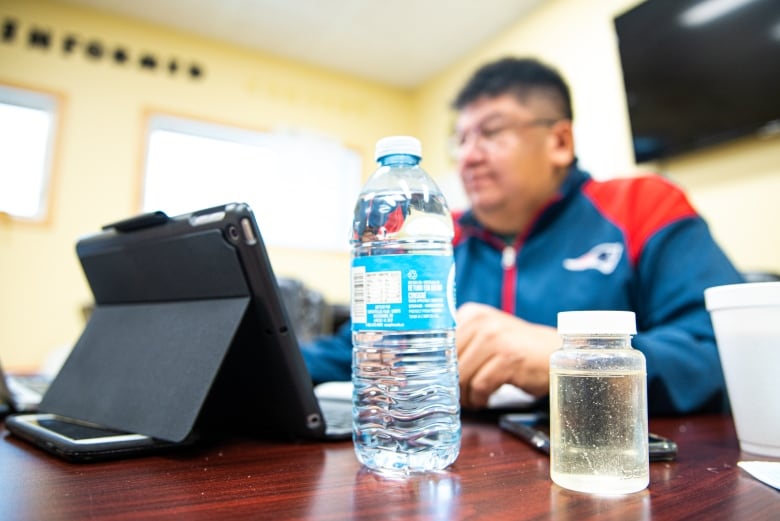
Members of a First Nation that has been under a boil-water advisory for longer than any other in Canada are hoping to return home before Christmas to clean running water for the first time in 25 years.
Neskantaga, accessible only by air and an ice road in winter, sits about 450 km north of Thunder Bay, Ont. — where nearly 300 of its members have been living in a hotel since an oily sheen in the reserve’s reservoir on Oct. 19 triggered their evacuation.
Now, final tests are taking place to determine whether Neskantaga’s water is safe enough for the community to use, weeks after members originally were scheduled to fly back and two years after the reserve’s water treatment plant was supposed to start producing clean drinking water.
The federal government is finalizing plans for the community to fly back as early as Friday.
Neskantaga Chief Chris Moonias said that even if the tests conclude the water is safe for drinking, he’s not prepared yet to lift the boil-water advisory. Residents have been using bottled water since 1995.
“Probably not. There’s a lot of work that needs to be done,” he said.
Moonias said the community’s perpetual crisis is the result not only of faulty machinery but of a bureaucracy that maintains the status quo of misery and marginalization in First Nations.
“The system needs to be fixed,” Moonias said of the policies in place to lift boil-water advisories.
“It’s designed the way it’s supposed to be running — to oppress First Nations in the country.”
A history of dislocation
In the late 1980s, due to infrastructure and flooding issues, Neskantaga was relocated to a spot about a 20-minute drive west, on a peninsula along Attawapiskat Lake known as Grandmother’s Point.
In Neskantaga’s old community, known as Lansdowne House, people used to have to fetch water from the Indian Affairs agency cabin because it was one of the few buildings connected to plumbing.
People gave up their log cabins (which were demolished) for the promise of a better life at a new location with improved services, including clean running water in each house.
In 1993, the federal department then known as Indian Affairs paid for the construction of a natural sand, low-filter water treatment plant.
But the facility failed to adequately disinfect the water and on Feb. 1, 1995, Neskantaga went under a boil-water advisory that has remained in place for a quarter of a century. Now, the people of Neskantaga say they won’t be ignored any longer.
WATCH: Peter Moonias on Neskantaga’s endless struggle for clean water
Peter Moonias, Neskantaga First Nation elder and former chief, addresses problems in the system to lift boil water advisories. 1:10
“In all my years, I’ve lived like this — struggling, fighting to be equal, to be treated fully human,” said 75-year-old elder Peter Moonias, who is a former chief.
“It hurts me when I see my granddaughter grow up like that. It hurts me when I see little ones crying who want to come home to their home here. It hurts. It really hurts and I wish the prime minister could feel what I feel.”
During the 2015 federal election campaign — on the day Neskantaga called for the next prime minister to intervene personally to address its water crisis — Liberal leader Justin Trudeau pledged to end boil-water advisories on reserves within five years.
Neskantaga became the poster community for Trudeau’s promise. The federal government originally set late 2018 as the deadline for upgrades to the water treatment plant, but problems began to crop up shortly after then-Indigenous Affairs Minister Carolyn Bennett visited the community in 2016 to announce the project.
Despite a series of red flags over the past few years, Indigenous Services Canada did not intervene in the water crisis, which led to two recent evacuations of the First Nation.
Earlier this month, the federal government announced more than $1.5 billion in new funding to finish lifting all long-term drinking water advisories across the country.
Ottawa promises a long-term plan
Since Neskantaga’s October evacuation, the work on upgrades to the water treatment plant has encountered several serious setbacks that included glitches in its new computer system, equipment failures and a contractor’s positive COVID-19 test, according to project update documents obtained by CBC News. On one occasion in 2019, during a two-week test of the system, the water plant’s discharge flooded the community’s sewage system.
These problems delayed the community’s repatriation date.
Neskantaga’s troubles have forced Indigenous Services Canada to re-examine its approach to dealing with long-term drinking water advisories and other infrastructure problems on reserves, according to senior government sources — who say it is quite clear the trust between Neskantaga and Ottawa is broken.
The federal government is now working on a long-term plan with the community that includes employing certified water operators for at least one year — with the possibility of an extension — to train local staff to maintain the plant, which is expected to hit full capacity this spring.
“I am prepared to support this proposal as an extraordinary measure given these unique circumstances,” Indigenous Services Minister Marc Miller wrote in a Dec. 15 letter to Chief Moonias.
The community is now drafting the terms of reference with Ottawa for a third-party investigation into Neskantaga’s 25-year-long water crisis and the business practices of the contractors, engineers and project management firms that have worked on the project and in other First Nations.
Ottawa also is funding a community representative for the water project. Chief Moonias said he wants that representative to keep an eye on the project manager, engineers, contracts and consultants doing the work.
“There are a lot of contractors who try to milk the system and milk some money from the community,” Moonias said.
The community is worried about possible leaks in the water lines and is working with the federal government to get a cost estimate for replacing its distribution system and possibly the sewer system as well, according to Miller’s letter to Moonias.
“A functional and sustainable distribution system must be a part of your water system moving forward,” Miller wrote.

The Ontario Clean Water Agency, a Crown agency of the Government of Ontario, noted deficiencies in the ongoing work to upgrade the water treatment plant — including mislabeled pipes, tags missing from almost all equipment and incomplete piping — according to November progress reports from the plant provided to the project team and the First Nation.
$1.9M legal settlement with contractor that didn’t finish work
Neskantaga itself has also imposed project changes on contractors since the work began in 2017.
Kingdom Construction Ltd. was awarded the project initially, but the Ayr, Ont.-based firm encountered early setbacks, including broken equipment, design problems with the roof and delays in the availability of a construction camp.
The company said the issues were outside its control, but the First Nation’s consultant, J.R. Cousin Consultants, disputed some of Kingdom’s claims and denied the company’s project extension requests.
The original schedule showed in-ground works and building construction were due to be completed before the winter of 2017-2018. Kingdom was still finishing the building foundation in February 2018 and the structure was not completed until the summer.
Neskantaga terminated its contract with Kingdom in February 2019 over the delays and a failure to provide a revised completion date for the project.
“We went there with the best of intentions,” said Gerald Landry, president of Kingdom. “In my opinion, the schedule was way too tight.”
Landry said the mechanism for dispute resolution in the Neskantaga contract was challenging because the First Nation had to ask the federal government for more money to address issues that were not in the contract, adding to the delays.
Landry said contracts for water projects on reserves are too rigid, leaving no room for unexpected challenges. He said he will not be doing any more work on reserves.
“The mechanism to execute the contract between parties is not flexible enough to resolve problems in a hurry,” he said.

Landry said Kingdom received a settlement of $1.9 million from Neskantaga this fall for the remaining work left in the contract. The settlement was paid by the federal government.
No damages were paid for breach of contract and Neskantaga maintains the community was acting within its rights when it took the work out of Kingdom’s hands, said the First Nation’s lawyer Evan Juurakko.
‘A total absence’ of supports for First Nations
Grand Chief Alvin Fiddler of Nishnawbe Aski Nation, which represents 49 communities in northern Ontario, said there needs to be a support system in place for First Nations like Neskantaga that are planning major infrastructure work.
“They [communities] don’t have any capacity to be able to, first of all, review the contracts and what is the responsibility that they have once they sign these contracts because there’s nothing else that comes with it,” Fiddler said.
“It’s just them on their own … That’s unfair when it comes to building a water treatment plant, where there’s so many technical details and also the legal obligations.”
Fiddler said communities need a way to get good legal and technical advice while working with their councils and elders.
The federal system that lifts boil water advisories, meanwhile, is long overdue for a review and substantial changes, said Assembly of First Nations Ontario Regional Chief RoseAnne Archibald.
She said the problem comes down to funding from Indigenous Services Canada.
“They often will make the lowest bids the accepted bids. And more often than not, First Nations might have a particular contractor that they know will do the work that they would like to see in the community, but they’re overruled in in those final stages with Indigenous Services Canada,” Archibald said.
“When you’re going with the lowest bid, sometimes that can lead to substandard work and that, of course, leads to situations like Neskantaga.”
Neskantaga’s current water crisis has been linked to a temporary pump installed by Razar Contracting Services, which replaced Kingdom on the project. Jeff Dyck, senior engineer on the project with J.R. Cousin Consultants, said the burned-out pump was the same model installed by Kingdom one year earlier — which also failed because it was used longer than intended.
Water sampling tests confirmed the oily sheen that was detected in the reservoir in late October was non-toxic mineral oil that came from a broken pump seal.
Dyck said the temporary pump wasn’t replaced earlier this year due to problems with the project, including work stoppages caused by COVID-19. A new, permanent pump is now in its place.
Dyck said there are still some kinks to sort out with the upgrade, but they should not affect the plant’s ability to provide water for the community’s current and future needs.














